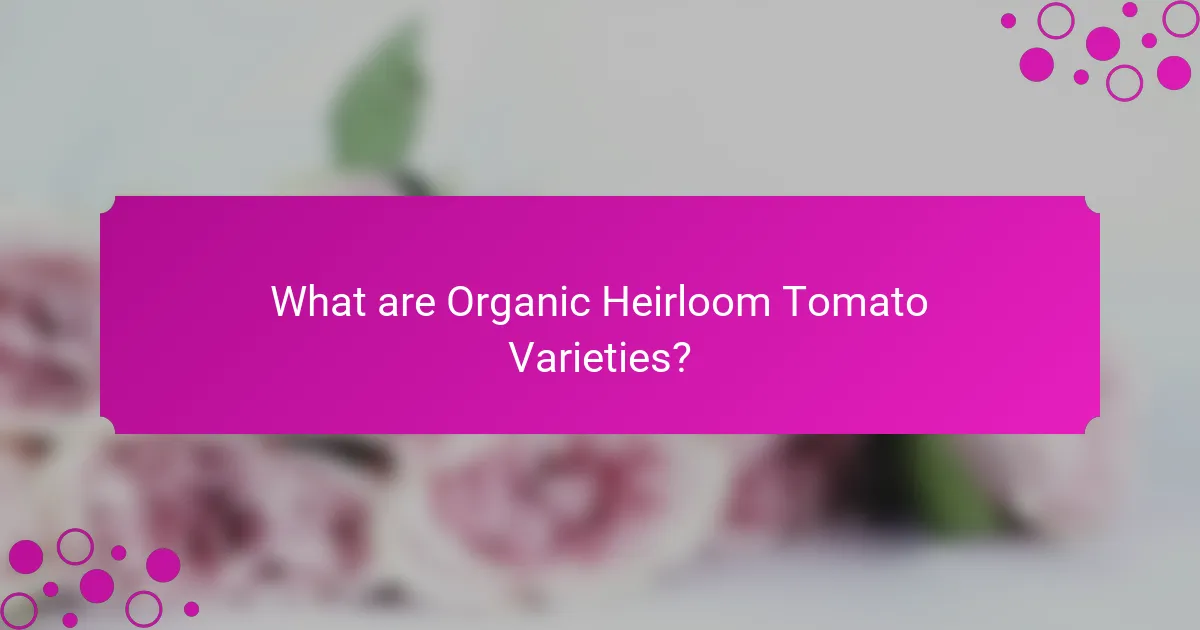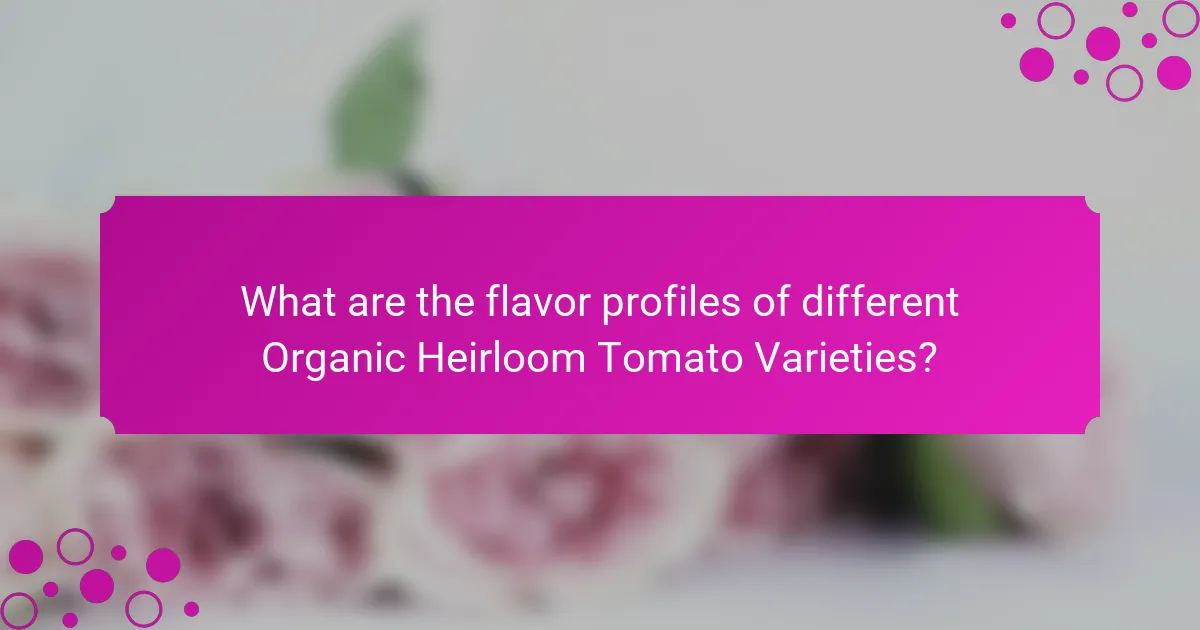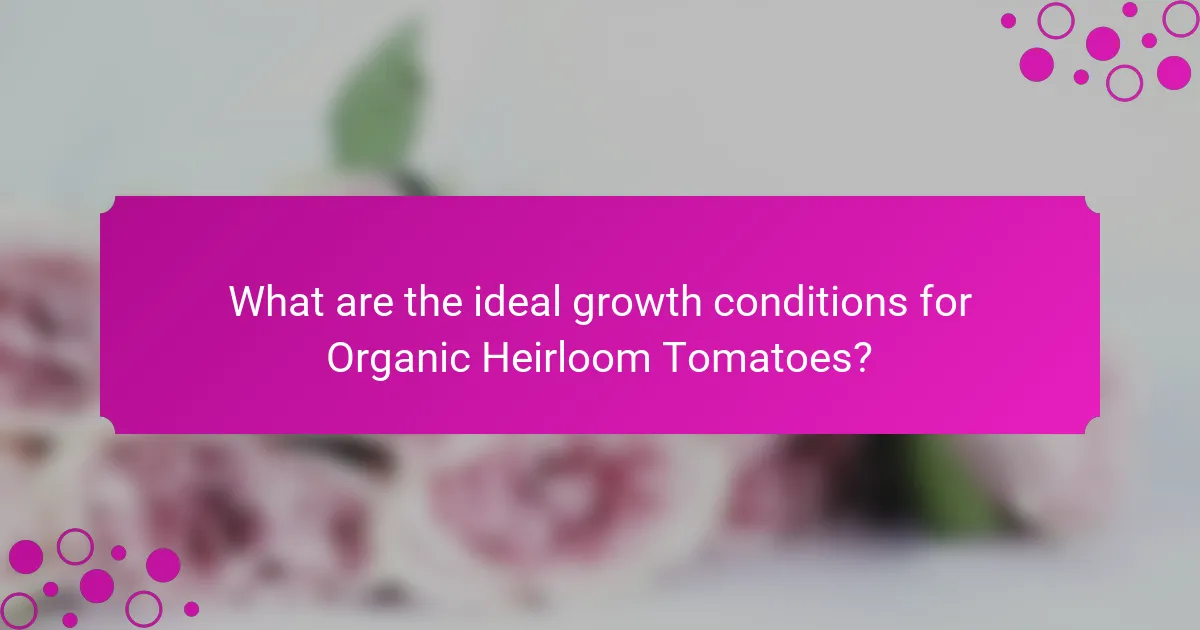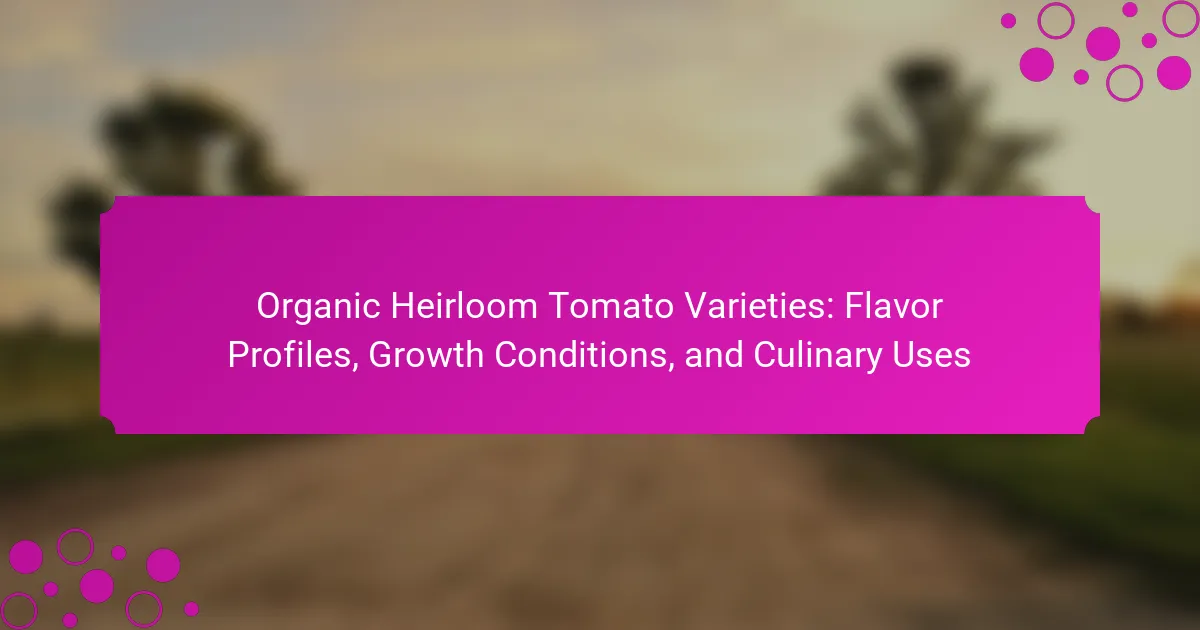Organic heirloom tomato varieties are traditional tomatoes cultivated from seeds passed down through generations, known for their rich flavors and unique characteristics. These open-pollinated tomatoes are grown without synthetic fertilizers or pesticides, contributing to agricultural biodiversity. The article explores various heirloom tomato types, such as Brandywine, Cherokee Purple, Green Zebra, and San Marzano, highlighting their distinct flavor profiles and culinary applications. Additionally, it outlines the ideal growth conditions for organic heirloom tomatoes, including soil requirements, watering needs, and temperature preferences, ensuring optimal fruit production.

What are Organic Heirloom Tomato Varieties?
Organic heirloom tomato varieties are traditional tomato types that have been cultivated for generations. They are grown from seeds that have been passed down through families or communities. These varieties are known for their rich flavors and unique characteristics. Unlike hybrid tomatoes, heirlooms are open-pollinated. This means they can produce seeds that will grow into plants identical to the parent. Organic heirloom tomatoes are cultivated without synthetic fertilizers or pesticides. They often exhibit a diverse range of colors, shapes, and sizes. The preservation of these varieties contributes to biodiversity in agriculture. Many chefs and home cooks prefer heirloom tomatoes for their superior taste and texture.
How do Organic Heirloom Tomatoes differ from conventional varieties?
Organic heirloom tomatoes differ from conventional varieties primarily in their cultivation methods. Organic heirloom tomatoes are grown without synthetic fertilizers or pesticides. This method promotes healthier soil and biodiversity. Conventional varieties often use chemical inputs that can affect taste and nutritional content. Heirloom tomatoes are also open-pollinated, meaning they can be saved and replanted. Conventional varieties may be hybrids, designed for uniformity and shelf life. Studies show that organic tomatoes can have higher antioxidant levels. This difference in cultivation leads to distinct flavor profiles, often described as richer and more complex.
What are the defining characteristics of heirloom tomatoes?
Heirloom tomatoes are defined by their open-pollinated seeds and rich genetic diversity. They are typically grown from seeds that have been passed down through generations. These tomatoes often exhibit unique flavors, colors, and shapes not found in commercial varieties. Heirloom tomatoes are usually grown in smaller quantities, emphasizing quality over quantity. They are known for their superior taste, which can vary significantly between different varieties. Many heirloom tomatoes are also more resilient to local growing conditions. Their cultivation practices often align with organic farming principles, promoting sustainable agriculture. The USDA defines heirloom varieties as those that have been cultivated for over 50 years, ensuring their historical significance.
Why are organic growing practices important for heirloom tomatoes?
Organic growing practices are important for heirloom tomatoes because they enhance flavor and nutritional value. Heirloom tomatoes thrive in organic conditions that promote biodiversity and soil health. Organic farming avoids synthetic pesticides and fertilizers, which can negatively impact flavor. Studies show that organic heirloom varieties often have higher antioxidant levels. Additionally, organic practices preserve genetic diversity, which is crucial for heirloom varieties. This diversity contributes to unique flavors and resilience against diseases. Overall, organic methods ensure that heirloom tomatoes maintain their distinctive qualities and health benefits.
What are the benefits of growing Organic Heirloom Tomatoes?
Growing organic heirloom tomatoes offers numerous benefits. They are known for their superior flavor compared to conventional varieties. Studies indicate that heirloom tomatoes often contain higher levels of antioxidants. These antioxidants contribute to better health outcomes. Organic heirloom tomatoes are also grown without synthetic pesticides or fertilizers. This practice promotes environmental sustainability and biodiversity. Furthermore, growing these varieties supports seed preservation efforts. Heirloom tomatoes help maintain genetic diversity in agriculture. This diversity can lead to more resilient crop systems.
How do heirloom tomatoes contribute to biodiversity?
Heirloom tomatoes contribute to biodiversity by preserving genetic diversity in cultivated plants. These varieties are often open-pollinated and have been passed down through generations. Each heirloom tomato variety has unique traits, such as color, shape, and flavor. This diversity helps maintain a wider gene pool for future breeding efforts. According to the Seed Savers Exchange, heirloom varieties can adapt to local growing conditions. They also support ecosystem resilience by attracting various pollinators. By cultivating heirloom tomatoes, gardeners can help protect these unique genetic resources. This practice fosters agricultural sustainability and food security.
What health benefits are associated with consuming heirloom tomatoes?
Heirloom tomatoes provide several health benefits. They are rich in antioxidants, particularly lycopene, which may reduce the risk of certain cancers. These tomatoes also contain vitamins A and C, which support immune function and skin health. Additionally, heirloom tomatoes are low in calories and high in fiber, promoting digestive health. Their unique flavor and nutrient density make them a valuable addition to a balanced diet. Research indicates that the consumption of tomatoes can lower blood pressure and improve heart health due to their potassium content.

What are the flavor profiles of different Organic Heirloom Tomato Varieties?
Organic heirloom tomato varieties exhibit diverse flavor profiles. For example, Brandywine tomatoes are known for their rich, sweet taste with a hint of acidity. Cherokee Purple tomatoes offer a complex, sweet flavor with earthy undertones. Green Zebra tomatoes provide a tangy and slightly sweet profile, distinguished by their unique striped appearance. San Marzano tomatoes are celebrated for their balanced sweetness and low acidity, making them ideal for sauces. Each variety’s flavor is influenced by its growing conditions, including soil type and climate. This diversity makes organic heirloom tomatoes popular among chefs and home cooks alike for various culinary applications.
How do flavor profiles vary among heirloom tomato varieties?
Flavor profiles among heirloom tomato varieties vary significantly based on their genetics and growing conditions. Each variety has distinct taste characteristics, ranging from sweet to tangy. For example, Brandywine tomatoes are known for their rich, sweet flavor. In contrast, Green Zebra tomatoes offer a more tart and zesty taste.
The growing environment can also influence flavor. Factors such as soil type, sunlight, and water availability affect sugar and acid levels in the fruit. Heirloom varieties typically exhibit more complex flavors compared to commercial hybrids. This complexity is due to their diverse genetic backgrounds and heritage.
Research indicates that heirloom tomatoes can contain higher levels of beneficial compounds, contributing to their unique flavors. A study published in the Journal of Agricultural and Food Chemistry found that heirloom varieties often have enhanced flavor profiles due to their higher antioxidant content.
What are the most popular heirloom tomato varieties and their flavors?
The most popular heirloom tomato varieties include Brandywine, Cherokee Purple, and Yellow Pear. Brandywine tomatoes are known for their sweet, rich flavor and large size. Cherokee Purple tomatoes have a unique, smoky taste with a deep purple color. Yellow Pear tomatoes are small, pear-shaped, and offer a mild, slightly sweet flavor. These varieties are favored for their distinct tastes and are commonly used in salads, sauces, and fresh dishes.
How does the growing environment affect the flavor of heirloom tomatoes?
The growing environment significantly affects the flavor of heirloom tomatoes. Factors such as soil quality, sunlight, temperature, and water availability play crucial roles. Rich, well-draining soil enhances nutrient uptake, leading to better flavor development. Adequate sunlight exposure increases sugar content, contributing to sweetness. Temperature fluctuations can influence acidity levels, affecting overall taste. Consistent watering promotes even growth and flavor consistency. Research shows that heirloom varieties thrive in specific climatic conditions, which can enhance their unique flavor profiles. For instance, tomatoes grown in warmer climates often exhibit a richer taste due to increased sugar concentration.
What culinary uses do Organic Heirloom Tomatoes have?
Organic heirloom tomatoes are versatile in culinary applications. They can be used in salads for their vibrant colors and flavors. Slicing them enhances sandwiches and burgers. They are also excellent for making sauces due to their rich taste. Roasting brings out their natural sweetness. Additionally, they can be used in salsas for fresh, zesty dishes. Their unique varieties allow for diverse flavor profiles in recipes. Organic heirloom tomatoes are often preferred by chefs for their quality and taste.
How can heirloom tomatoes be used in various recipes?
Heirloom tomatoes can be used in various recipes to enhance flavor and nutrition. They are versatile ingredients suitable for salads, sauces, and salsas. In salads, heirloom tomatoes add vibrant colors and unique tastes. They can be sliced and combined with fresh basil and mozzarella for a classic Caprese salad. In sauces, heirloom tomatoes can be roasted or simmered to create rich pasta sauces. Their natural sweetness enhances the overall flavor profile. For salsas, diced heirloom tomatoes can be mixed with onions, cilantro, and lime for a fresh topping. Additionally, heirloom tomatoes can be grilled or stuffed for more elaborate dishes. Their diverse varieties offer different flavors, making them ideal for experimentation in the kitchen.
What are the best preparation methods to enhance their flavor?
The best preparation methods to enhance the flavor of organic heirloom tomatoes include roasting, grilling, and fresh consumption. Roasting tomatoes concentrates their sweetness and deepens their umami flavor. Grilling adds a smoky char that complements the natural acidity. Fresh consumption, such as in salads or salsas, preserves their bright, fresh taste. According to a study published in the Journal of Agricultural and Food Chemistry, cooking methods can significantly alter the flavor profile of tomatoes, enhancing their sweetness and reducing bitterness.

What are the ideal growth conditions for Organic Heirloom Tomatoes?
Organic heirloom tomatoes thrive in warm climates with full sun exposure. They require well-draining, nutrient-rich soil with a pH of 6.0 to 6.8. Consistent moisture is essential, ideally through deep watering once a week. These tomatoes benefit from organic fertilizers, especially those high in potassium. They perform best at temperatures between 70°F and 85°F during the day. Nighttime temperatures should not drop below 55°F. Proper spacing of 24 to 36 inches between plants allows for adequate airflow. These conditions promote healthy growth and optimal fruit production.
What soil conditions are best for growing heirloom tomatoes?
Heirloom tomatoes thrive in well-draining, loamy soil rich in organic matter. The ideal pH level for this soil is between 6.0 and 6.8. This range promotes optimal nutrient availability for the plants. Ample organic matter improves soil structure and moisture retention. Good drainage prevents root rot and other diseases. Additionally, incorporating compost enhances soil fertility. Regular soil testing can help maintain these conditions. These factors contribute to healthy growth and fruit production in heirloom tomatoes.
How does pH level impact heirloom tomato growth?
pH level significantly impacts heirloom tomato growth. Tomatoes thrive best in soil with a pH between 6.0 and 6.8. This pH range promotes optimal nutrient availability. Nutrients like nitrogen, phosphorus, and potassium become more accessible in this range. A pH below 6.0 can lead to nutrient deficiencies. For example, calcium deficiency occurs in acidic soils. Conversely, a pH above 6.8 can hinder iron absorption, causing chlorosis. Studies show that pH levels directly influence plant health and yield. Maintaining the right pH can enhance fruit quality and flavor.
What nutrients are essential for healthy heirloom tomato plants?
Heirloom tomato plants require several essential nutrients for optimal health. Key nutrients include nitrogen, phosphorus, and potassium. Nitrogen promotes leaf growth and overall plant vigor. Phosphorus aids in root development and fruit maturation. Potassium enhances fruit quality and disease resistance. Calcium is crucial for cell wall structure and preventing blossom end rot. Magnesium supports photosynthesis and enzyme function. Micronutrients like iron, manganese, and zinc also play vital roles in plant health. A balanced supply of these nutrients ensures robust heirloom tomato plants and high-quality fruit production.
What environmental factors influence the growth of heirloom tomatoes?
Heirloom tomatoes grow best in specific environmental conditions. Key factors include temperature, sunlight, soil quality, and moisture levels. Heirloom tomatoes thrive in temperatures between 70°F and 85°F. Insufficient sunlight can reduce fruit production. Ideally, they need at least six to eight hours of direct sunlight daily. Nutrient-rich, well-draining soil promotes healthy growth. Soil pH should ideally range from 6.0 to 6.8 for optimal nutrient uptake. Consistent moisture is crucial, but overwatering can lead to root rot. These factors collectively influence the yield and quality of heirloom tomatoes.
How do temperature and sunlight affect heirloom tomato yield?
Heirloom tomato yield is significantly affected by temperature and sunlight. Optimal temperatures for heirloom tomatoes range from 70°F to 85°F. When temperatures exceed 90°F, pollination can be negatively impacted, leading to reduced fruit set. Conversely, temperatures below 50°F can stunt growth and delay ripening. Sunlight is equally crucial; heirloom tomatoes require at least six hours of direct sunlight daily for optimal growth. Insufficient sunlight can result in fewer and smaller fruits. Studies show that tomatoes exposed to full sun produce yields up to 20% higher than those in partial shade. Therefore, maintaining ideal temperature and sunlight conditions is essential for maximizing heirloom tomato yield.
What pests and diseases should be monitored when growing heirloom tomatoes?
Heirloom tomatoes should be monitored for several pests and diseases. Key pests include aphids, whiteflies, and spider mites. Aphids can weaken plants by sucking sap. Whiteflies transmit viruses and can cause yellowing of leaves. Spider mites thrive in dry conditions, leading to stippling on leaves.
Diseases to watch for include blight, blossom end rot, and mosaic virus. Blight can cause rapid leaf decay and fruit rot. Blossom end rot is linked to calcium deficiency, resulting in sunken spots on fruit. Mosaic virus leads to mottled leaves and stunted growth. Regular monitoring and early intervention can help manage these issues effectively.
What are some best practices for cultivating Organic Heirloom Tomatoes?
To cultivate Organic Heirloom Tomatoes effectively, start with selecting disease-resistant varieties. This choice minimizes potential crop loss from common tomato diseases. Next, prepare well-drained, nutrient-rich soil with organic compost to enhance growth. Soil pH should be between 6.0 and 6.8 for optimal nutrient uptake.
Water consistently, ensuring the soil remains moist but not soggy. Aim for deep watering to encourage strong root development. Mulching helps retain soil moisture and suppress weeds. Prune plants regularly to improve air circulation and reduce disease risk.
Fertilize with organic options, such as fish emulsion or bone meal, to provide essential nutrients. Monitor for pests and diseases, using organic pest control methods when necessary. Crop rotation is also crucial to prevent soil depletion and pest buildup.
These practices ensure healthy growth and better yields of Organic Heirloom Tomatoes.
How can gardeners ensure a successful heirloom tomato harvest?
Gardeners can ensure a successful heirloom tomato harvest by selecting the right varieties and providing optimal growing conditions. Heirloom tomatoes thrive in well-drained, nutrient-rich soil with a pH between 6.0 and 6.8. They require full sunlight for at least six to eight hours daily. Consistent watering is crucial; tomatoes need about 1-2 inches of water per week. Gardeners should also use organic fertilizers to promote healthy growth. Regular pruning helps improve air circulation and reduces disease risk. Monitoring for pests and diseases is essential for maintaining plant health. Crop rotation can prevent soil depletion and disease buildup. These practices contribute to higher yields and better fruit quality.
What common mistakes should be avoided when growing heirloom tomatoes?
Common mistakes to avoid when growing heirloom tomatoes include overwatering, which can lead to root rot. Heirloom tomatoes require well-drained soil to thrive. Another mistake is planting too early, as frost can damage young plants. Heirloom varieties often need warm soil for germination. Additionally, neglecting to provide adequate support can cause plants to break under their weight. Pruning is essential to promote airflow and prevent disease. Lastly, failing to rotate crops can lead to soil depletion and increased pest issues. These practices are crucial for a successful heirloom tomato harvest.
Organic heirloom tomato varieties are traditional, open-pollinated tomatoes cultivated without synthetic fertilizers or pesticides, known for their rich flavors and unique characteristics. This article explores the differences between organic heirloom and conventional tomatoes, highlighting their defining traits, health benefits, and contributions to biodiversity. It also examines the ideal growth conditions, environmental factors, and best practices for cultivation, while detailing the diverse flavor profiles and culinary uses of popular heirloom varieties. By understanding these aspects, readers can appreciate the significance and advantages of growing and consuming organic heirloom tomatoes.
